FIDE World Fischer Random Chess Championship – Call for Bids
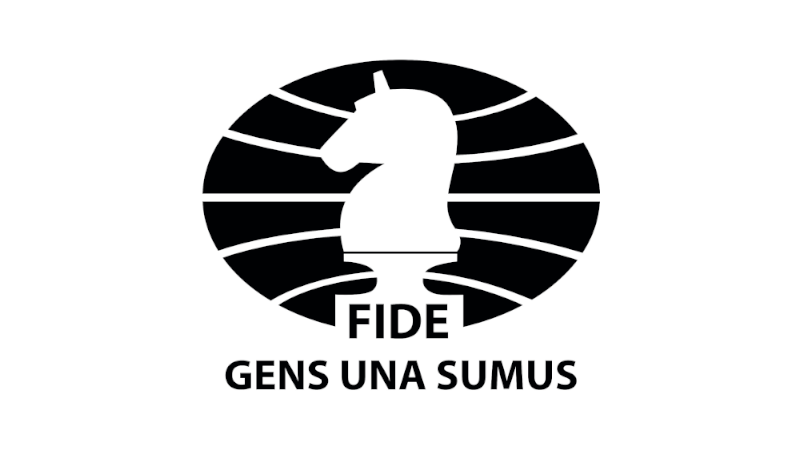
1.1 The International Chess Federation (FIDE) will hold the next FIDE World Fischer Random Chess Championship from February 19-25, 2024. 1.2 FIDE is opening a bidding procedure to invite any federation member of FIDE or any organiser approved by the national federation to host the event. The federation’s letter of support may be provided later when the bid’s evaluation procedure is launched. 1.3 The proposed format is one used for the FIDE World Fischer Random Chess Championship 2022 (handbook.fide.com/files/handbook/FRCCRegulations2022.pdf). 1.4 The bid may contain proposals on the event’s format modification, including qualification and main tournament systems, time control and commercial conditions. The FIDE Council shall decide whether these conditions are admissible. 1.5 The minimum prize fund of the event shall be 400,000 USD. 1.6 The Bidding Form shall be filled in by an Applicant. A signed copy shall be submitted as e-mail messages to the FIDE Secretariat to office@fide.com from August 23 to October 20 2023, 23:59 Lausanne time (FIDE has a right to extend this deadline). All the documents shall be submitted in English. Additional documents may be requested by the FIDE General Strategy Commission (GSC) for further evaluation. 1.7 Once the Organiser is granted the right to organise the event, a relevant announcement shall be made on the FIDE website. FIDE Technical Delegate (FIDE TD) may be appointed at the same time to supervise the event on behalf of FIDE in consultation with GSC.
Clash of chess titans in Düsseldorf: World Rapid Team Championship preview

The first-ever World Rapid Team Championship is set to start in Dusseldorf, bringing together spectacular players from all across the globe The stage is set for an unprecedented showdown from the 25th until the 29th of August as the chess elite will gather in Germany for the inaugural world team championship in rapid chess. Forty teams from all corners of the world are registered to take part in the tournament. Stellar line-up A number of the world’s strongest players are scheduled to take part in the event. The list of contenders reads like a “who’s who” of the chess world: Wesley So, Levon Aronian, Fabiano Caruana, Ian Nepomniachtchi, Maxime Vachier-Lagrave, Jan-Krzysztof Dudam Richard Rapport, Peter Svidler, Alexander Grischuk and Daniil Dubov. Joining them will be two former world champions – Vishy Anand and Vladimir Kramnik (who will be playing for the humorously named Chess Pensioners team) as well as the former World Champion Candidate, Nigel Short. Among women players taking part are former World Champions Hou Yifan, Alexandra Kosteniuk, and Mariya Muzychuk, as well as strong woman players such as Kateryna Lagno, Elisabeth Paehtz, Harika Dronavali and Polina Shuvalova. The full list of players taking part can be found here. The frontrunners Among the 40 teams taking part, there are two very strong contestants for first place. With an average rating of 2542, the top favourite of the event is team “Freedom”, headed by Emil Sutovsky. With the likes of Vidit, Dubov, Rapport and Najer in the team, as well as Polina Shuvalova, they are the top team vying for first place. Another strong contender is the WT Chess Team. Made up of former Women’s World Champions Hou Yifan and Alexandra Kosteniuk, two-time World Championship candidate Ian Nepomniachtchi and a list of super-strong young talents – Praggnanandhaa, Abdusattorov, Keymer and Duda, they will be the team to watch out for. However, the fact that each team has to have a recreational player in their ranks who has never achieved a rating of 2000 in any FIDE category will have a huge effect on the results. The full list of teams, including team composition, can be found here. Team structure Each team will consist of at least six but no more than nine players. Apart from having to include at least one female player, for the first time in a high-level club event, teams will have to include a recreational player, who has never achieved a Standard, Rapid or Blitz FIDE rating of 2000 or more. The teams are not required to assign board numbers in rating order, which allows a chance for some unique board matchups, setting the scene for potential surprises. Each match is played on six boards, which means that the team captains (who may also be players) can decide who will play and who will rest in their nine-member squad. The format The event is 12-round Swiss tournament. The first named team in a pairing shall have the white pieces on the odd-numbered boards and the black pieces on the even-numbered boards. The time control will be 15 minutes, with a 10-second increment from move one. The scoring will be based on matchpoints: a win scores two points, a draw scores one point and a loss means zero points. A team with the highest number of matchpoints in the relevant final standings shall be declared World Rapid Team Champion. The regulations of the event can be found here. Prizes The tournament will feature a 250,000 Europe prize fund, with the prizes distributed in the following order: In case of a tie, the prize money shall be distributed according to the tie breaks. Event coverage FIDE will be providing its coverage of the event with a dedicated live programme on FIDE’s official YouTube and Twitch channels. Commenting on the games will be our-time US champion and one of the most prominent chess figures GM Yasser Seirawan. He will be joined by GM Maurice Ashley and the European Women’s Individual Chess Champion, and a seven-time French Women’s Champion WGM Almira Skripchenko. The venue & spectators The tournament will be played in Dusseldorf’s Rheinterrasse (Address: Joseph-Beuys-Ufer 33, 40479 Düsseldorf), located right in the heart of Dusseldorf, directly on the Rhine. Spectators who wish to follow the event can attend free of charge from 26-28 August, from 13:00 until the end of the games. The entrance to the playing hall with smartphones or any other electronic devices will be prohibited. Such devices should be left in the lockers, which will be located outside of the playing area. To get fast-track access to the event, click here. Schedule: August 25 — Arrival August 29 — Departure The organisation The event is organised by FIDE in partnership with WR Group Holding GmbH – an international provider of certification, project logistics and customs services. All official information about the tournament can be found on the event website: worldrapidteams2023.fide.com/ Text: Milan Dinic
EDU Commission announces its 10th Preparation of Teachers course
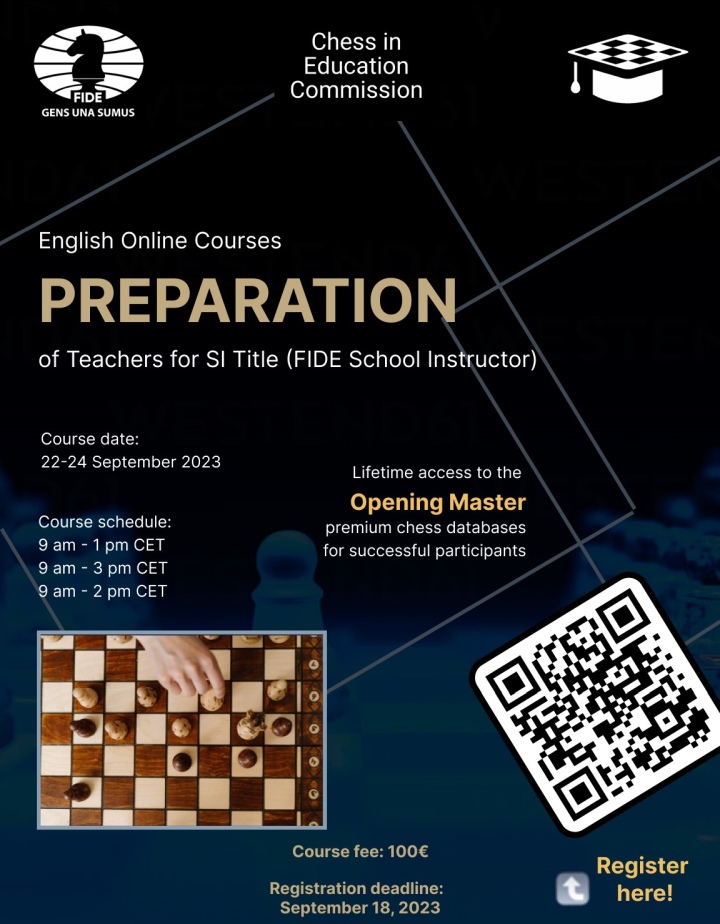
FIDE Chess in Education Commission is pleased to announce the dates of the new Preparation of Teachers course. The course will be held online in English from September 22-24, 2023. The target audience is teachers, chess educators, beginner and advanced players with basic chess knowledge and experience working with children. Participants, based upon their exam results, qualify for the FIDE title of School Instructor. Upon successful completion of the course, participants will be offered lifetime access to the Opening Master premium chess database, which currently contains over 9.6 million official over-the-board chess games and is growing on a monthly basis. Read the detailed course description here. Candidates who wish to attend the course must complete and return the registration form. The cut-off date for applications is September 18. Applicants are accepted on a first-come, first-served basis, and the maximum number of places on the course is 20. If you have any questions, please feel free to contact us at edu.courses@fide.com
FIDE World Cup: Carlsen and Praggnanandhaa draw in the first game of the finals
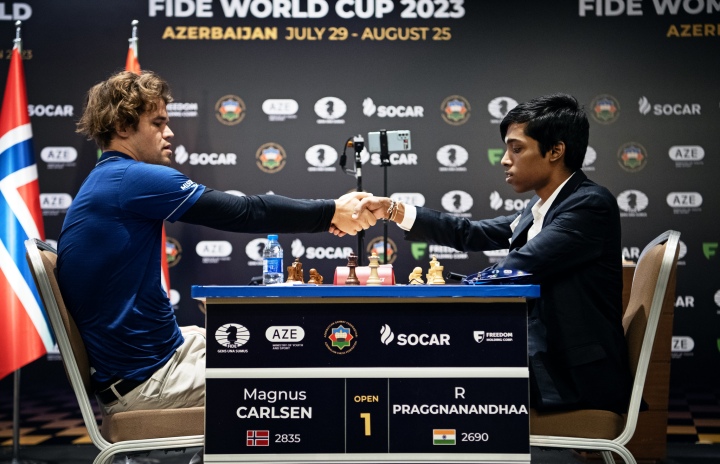
Playing as White, the 18-year-old Indian prodigy, R Praggnanandhaa, couldn’t obtain a significant advantage over the former World Champion Carlsen. Meanwhile, Fabiano Caruana suffered a surprising defeat against local player Nijat Abasov in the match for third place Magnus Carlsen and R Praggnanandhaa split a point after a game which lasted 35 moves and around three hours. In the Four Knights line of the English Opening, R Praggnanandhaa (as White) went for a sharp line, putting pressure on the queenside, but Carlsen responded with a counter-push in the centre and comfortably equalised. In an even position, with three Kingside pawns and a knight and a rook each, the two decided to call it a day. In the aftermath of the game, Magnus Carlsen expressed his discomfort during the post-game interview, revealing that he was feeling unwell due to food poisoning. Despite his health setback, Carlsen’s performance on the board remained formidable. In the match for third place, Fabiano Caruana suffered a defeat at the hands of Nijat Abasov, making a critical mistake in the final stage of the game. In the Catalan Opening, the position was even until move 16, when White (Abasov) started the ball rolling by doubling his rook along the g-file. Abasov then proceeded to organise an attack on the Black king’s fortress, but Caruana had sufficient defensive resources. Unfortunately for the American, he tripped up on move 23, immediately landing in an effectively lost position. Three moves later, he resigned. An upsetting defeat for the former World Champion Candidate, who will have to win tomorrow’s game to reach the tiebreaks and fight for third place. Caruana will have a slight advantage tomorrow as he will be playing with the white pieces. Here follows a closer look at today’s games: Although intense, today’s game between Praggnanandhaa and Carlsen did not bring much excitement. In the Four Knights Kingside Fianchetto of the English, Praggnanandhaa pressed on the queenside, but Magnus effectively defused the tension. 17…Bc6 With this move, Carlsen parried all the threats and steered into an equal endgame. In the line 18.Bxc6 bxc6 White can’t take the c6-pawn in view of 19…Rc8. 18.Qxd8 Rfd8 19.Bxc6 bxc6 White has a passer on the a-file, but Black has enough time and pieces to stop it from progressing, and he also has countering resources in the centre. In the following moves, the a-pawn was exchanged for a black pawn in the centre, and the two reached the following position in which they decided to draw: If one takes into account Carlsen’s claim that he wasn’t feeling well due to food poisoning, the willingness to go for a calm draw was understandable. ½ – ½ Fabiano Caruana defended well in the Catalan against Nijat Abasov, but a slip by the American allowed White to obtain a winning position. White is preparing for an assault on the black king. The most straightforward move was to get the knight to e4, bringing it into the attack. Abasov played 22.Qe3 (22.Ke4 and 22.Ne2 were much better options), which the engines consider as a mistake, suggesting that the position is now even. Black should have responded with 22…f5!, aiming to numb White’s attack. Caruana went for 22…Nb6 and after 23.Be4 Black made a fatal blunder. 23…Qb4?? Leaving the f6-square undefended. 24.Bxh7 Kxh7 25.Ne4 Qe7 – the queen returned to defend, but now it’s too late. 26.f5! Black resigned. There is no reasonable defence against 27.Nf6 followed by 28.Qxh6+ with checkmate to follow. 1-0 Text: Milan Dinic Photo: Stev Bonhage and Maria Emelianova (chess.com) About the event The FIDE World Cup 2023 is taking place from 29 July to 25 August 2023 in Baku, Azerbaijan. In the Open tournament, 206 players were eligible to take part and 103 in the Women’s event. There will be eight rounds in the Open and seven in the Women’s tournament. Each round will be played under a knock-out system, consisting of a 2-game match. In the case of a tie, the players will play a rapid and, if necessary, a blitz tiebreak until the winner is determined. The winners of the top three places in both sections will qualify for the 2024 Candidates tournament. In both events, the time control for each game is 90 minutes for the first 40 moves, followed by 30 minutes for the rest of the game with an increment of 30 seconds per move starting from move 1. The prize fund for the entire event is 2.5 million US Dollars, with $1,834,000 in the Open and $676,250 in the Women’s tournament. The 2023 FIDE World Cup has the largest prize fund for any chess tournament ever played. More information about the event: worldcup2023.fide.com/ Regulations: Open tournament: handbook.fide.com/files/handbook/WorldCup2023Regulations.pdf Women’s event: handbook.fide.com/files/handbook/WWorldCup2023Regulations.pdf Schedule: worldcup2023.fide.com/schedule
Goryachkina wins Women’s World Cup
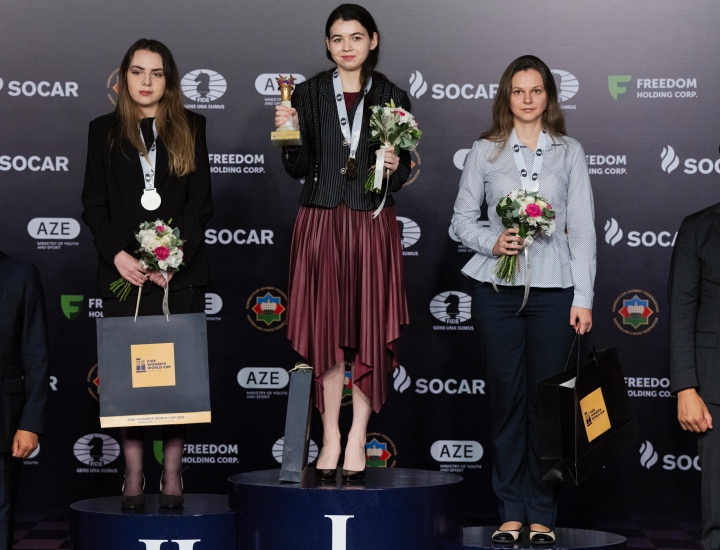
The 18-year-old Indian prodigy defeated the favourite Fabiano Caruana after winning the second tiebreak 1.5-0.5. Earlier in the day, Aleksandra Goryachkina defeated Nurgyul Salimova to clinch the title in the Women’s tournament Baku witnessed an intense day as two nail-biting tiebreak matches unfolded. In the Women’s finals, Aleksandra Goryachkina won the title by defeating Nurgyul Salimova, however, the outcome could easily have been different. In a major upset, the favourite Fabiano Caruana was ousted by 18-year-old R Praggnanandhaa in the open category following two tiebreak rounds. The Open Tournament Highlights After two draws in the regular part of the semi-finals, former challenger Fabiano Caruana and the rising star from India, R Praggnanandhaa, met in the tiebreaks to decide who would go to the finals. The initial two rapid tiebreak games ended in draws. Notably, Caruana had a winning position in the first tiebreak game but failed to capitalise, allowing Prag to evade defeat. In the second game, both sides were equal throughout. Then, in the second rapid tiebreak match – where the time controls moved from 25 to 10 minutes each – Praggnanandhaa played significantly better in the first game, gaining the upper hand on the white side of the Italian Game. Caruana correctly sacrificed a pawn and reached equality but then played somewhat sluggishly and allowed his opponent to consolidate. Pragg then advanced his pawns, capturing one and subsequently launching an assault on Black’s Queenside, joined by the white king. Even though White promoted a second queen, Caruana continued to resist, hoping for a miracle. Unfortunately for the American, Pragg was confident in his execution and secured victory. In the second game, Praggnanandhaa again achieved a better position (this time as Black). In the endgame, the Indian was completely winning, but he allowed White to make a comeback, and the game ended in a draw, thus eliminating Caruana. This will be the first final for R Praggnandnhaa in the World Cup, where he will be facing Magnus Carlsen (who will also be playing his first World Cup final). Caruana will go up against Nijat Abasov in the battle for third place. The finals of the Open World Cup, as well as the match for third place, will be held on Tuesday, 22nd of August. The Women’s Tournament Highlights In today’s tiebreak match, Goryachkina was completely lost in the first game. Playing the London System, Salimova (as White) had a clear advantage early on but then misplayed in a completely winning position, allowing Goryachkina to save a draw with a perpetual check. In game two, in the Catalan, Goryachkina managed to secure an extra pawn on the queenside as her opponent did not demonstrate the necessary knowledge and accuracy in the opening. In the endgame, she was close to clinching victory on two occasions but allowed Black to make a save. After 89 moves, in time trouble – in a 2:1 pawn endgame for Goryachkina where White had a knight, and Black had a bishop – Salimova eventually cracked in a drawish position and made the decisive mistake. White managed to penetrate with her king to the kingside to support her two passers that rushed towards promotion. Black resisted a bit more before resigning on move 105. A great victory by Aleksandra Goryachkina who was the runner-up in the 2021 edition of the event. Additionally, she secured the first-place prize of $50,000. Goryachkina has confidently played the entire event: out of six matches, in four she won in the regular part (against Odraz Valdes, Divya, Batsiashvili and Tan), and in two she won in the tiebreaks (against Dronavalli and Salimova). Despite losing in the finals, Bulagria’s Nurgyul Salimova had a spectacular performance in Baku and is a huge surprise for the chess world. She defeated some of the strongest world players, such as Polina Shuvalova and Anna Muzychuk (who finished third in the Women’s World Cup). Here follows a closer look at some of the top games of the day: We begin with the tiebreak match between Aleksandra Goryachkina and Nurgyul Salimova. Goryachkina had a lucky escape in the regular part of the match, securing a tiebreak. Even today, as the match started, it seemed that Salimova was the better player. She completely dominated Goryachkina in their first rapid tiebreaker. Diagram after 14.Bd2 By this point, the position was around even, but now Goryachkina made a series of moves, after which she ended up completely lost. 14…Be7? (14…f6! dislodging the white knight was necessary) 15.b3! Rc8 16.Rc1 c5? 17.Na5?! Qa6? 18.dxc5 Rxc5 19.Rxc5 Bxc5 20.b4 White is quickly advancing her queenside pawns, getting complete control over the position. 20…Bb6 21.b5 Qc8 22.Nac6 O-O 23.Qf3 f6 24.Nc4 Bc5 25.Be3! Nxe3 26.Nxe3 Kh8 27.Nxf5 exf5 28.Qd5 White is completely winning. However, Salimova was in time trouble and soon she started to err… 28…Bb6 29.a5 Bc7 30.Nxa7 Qb8 31.Nc6 Bxh2+ 32.Kh1 Qf4 All of the sudden Black has some threats. 33.Qf3? The first big mistake by White. She should have just continued with 33.Nd4! Now 33…Qh4 is met with 34.Nf6, while 34…Qh6 fails to 35.Nxf5 33…Qh4 34.Qh3 Qc4 35.Kxh2?? Another blunder. White was still winning after a precise 35.Rb1. Now it’s around even. 35…Qxf1 36.Qxf5 Qc4 37 a6 g6 38.Qd7 Qf4+ And now it’s perpetual. 39.Kg1 Qc1+ 40.Kh2 Qf4+ 41.Kg1 Qc1+ 42.Kh2 ½ – ½ Goryachkina made two consecutive saves in her match against Salimova. To win, she had to take control of the situation and not rely on luck. That is exactly what happened in the second tiebreak game, as Salimova started blundering early on. This well-known theoretical position is around even, but Black did not play the main move 12…Bd5, tested on the highest level, but opted for less precise 13…c5 and after 14.dxc5 Na6 15.Qxc5 White emerged with an extra runner on the queenside. Alexandra was gradually making progress and reached a winning position. White’s only problem is that her king is a bit restricted. With this in mind, Alexandra should have played 36.e3! removing Black d4 pawn. However, Goryachkina made several mistakes, allowing Black to equalise. 36.Be4 Nf6 37.Bd3
FIDE World Cup Round 7 Day 2: Ukrainian Anna Muzychuk wins bronze
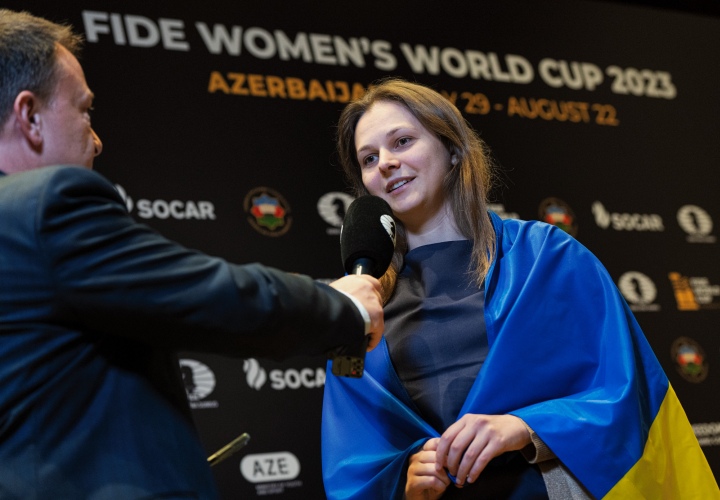
Anna Muzychuk defeated former Women’s World Champion Tan Zhongyi by 1.5:0.5 and took third place. In the Open, Magnus Carlsen qualified for his first-ever final in this competition Anna Muzychuk has won third place in the Women’s World Cup after drawing in today’s game against former World Champion Tan Zhongyi. She scored in the first game, winning the match 1.5:0.5. In a post-game interview, Anna – with the Ukrainian flag on her shoulders, a gift from the Ukrainian ambassador to Azerbaijan – thanked everyone for their support and to those who helped and are helping her and her family who now live in Spain. In the Women’s finals, Aleksandra Goryachkina had a lucky escape with a draw against Nurgyul Salimova, as the two head for the tiebreaks. The former World Champion Magnus Carlsen has qualified for his first-ever final of the Open World Cup tournament after drawing as Black against Nijat Abasov of Azerbaijan. The Norwegian won in the first game, so a draw was enough. Carlsen’s biggest success at the World Cup so far was clinching third place in the 2021 event in Sochi. Now, he will fight for a chance to add the only missing jewel in his crown of tournament victories. The second semi-final match, between R Praggnanandhaa and Fabiano Caruana, goes to the tiebreaks after another draw following a tense battle which lasted over four and a half hours. The Women’s Tournament Highlights In their second game of the match for third place, Anna Muzychuk (playing as Black) achieved a significant advantage as early as move 10. After White’s 22nd move, Black was on the brink of scoring a victory with a piece sacrifice which Muzychuk didn’t see. Throughout the game, Black had the initiative and was pushing, but the Ukrainian could not find the best moves to secure a victory. In the end, the two reached a drawn bishop endgame. The longest game of the day was in the fight for first place between Nurgyul Salimova and Aleksandra Goryachkina. Playing as White, Salimova achieved a significantly better position against Goryachkina by move 33. By move 45, White was winning. Unfortunately for Salimova, she made several mistakes in the endgame, which was enough for Goryachkina to reach safety. Moreover, Aleksandra then tested Nurgyul in a rook and knight vs rook drawing endgame for quite a while before they agreed to split a point. The winner of the Women’s World Cup will be decided in the tiebreaks. The Open Tournament Highlights Magnus Carlsen only needed a draw to get through to the finals. To stay in the race, his opponent Nijat Abasov (the Azeri star who surprisingly reached the finals) needed to win in this game where he was playing as White. Abasov went for the London system – an opening which does not require detailed knowledge of many lines and which also allows White to achieve a solid position. In the first part of the game, White got a slight edge, but soon it was Black exerting some pressure on the opponent’s position. As the situation started clearing in the centre, the two reached an equal endgame with two rooks and a bishop each, where neither side had a chance to make progress. After trading the rooks, Magnus gave up his bishop to end up with two runners on the Queenside, but White was just in time to hold, and a draw was agreed after all the pieces were exchanged on the board. Despite losing this match, Nijat Abasov is still in the race, but he will be fighting for third place. R Praggnandnandhaa and Fabiano Caruana drew again today. In the Catalan, White (Praggnanandhaa) made a mistake right after the opening, which allowed Black some chances, but Caruana decided not to take them. In a complicated game with plenty of manoeuvring and tactics, Black emerged slightly better, but Pragg held his ground with an accurate defence. In the end, the opponents advanced passers on the opposite wings, but after trading them, they realised it was time for a draw. The tiebreaks will take place on Monday, 21st of August. Here follows a closer look at some of the top games from the second day of the semi-finals of the Open and the finals in the Women’s World Cup: Praggnanandhaa, playing with White, made an imprecision in the early stage of the game, allowing Black some chances that Caruana did not utilise. White has just played 15.Na3? Taking on c6, followed by Rc1 and pressuring the weak pawns on the c-file, was the best option. Now, Black had a good chance to grab the initiative with 15…Nxd4 16.Bxb7 Rb8 17.Bxa6 e5! 18.Qe3 Ng4 with powerful pressure on both wings. It seems that, however, Caruana either missed it or did not feel comfortable venturing down this line and went for 15…g5 16.Qe3 Qxd4 17.Qxd4 Nxd4 18.Bxb7 Ra7 19.Bg2 Rb8 20.Rd1 c5 Black was pressuring in the endgame, but Pragg demonstrated accuracy in defence and found the only move to hold his ground in the end. It looks like White’s a4 is doomed, but Pragg found 34.Na1! With this paradoxical move in the corner, White was right in time to protect his queenside pawns. After 34…Nc5 (exchanging the knights would have been devastating for Black) 35.b3 Rb4 36.Ke3 f5, the position is even. 37.Kd2 f4 38.Kc3 Rb8 39.gxf4 gxf4 40.a5 Ne4+ 41.Kb2 f3 42.Nc2 43.f2 Rf1 e5 44.a6 Nc6 45.Nb4 Ra8 46.Rxf2 Nxa6 47.Nc6 and the two agreed to split a point. ½ – ½ Anna Muzychuk was significantly better in the second game against Tan Zhongyi. Despite finishing the game with a draw, that was enough for third place. It was a more than fair outcome, given how well Anna played today and in the first game against Tan. After several imprecisions by Tan, Anna grabbed the initiative right in the opening and, by move 21, got a chance for a spectacular finish. Black could have launched a devastating attack with 21…Bxc3 22.bxc3 Rab8 23.Qd4 Rb1+ 24.Kd2 Rb2+ and White’s position is desperate. Instead, Muzychuk went for 22…Rae8 23.Ba6
5th FIDE World Championship for People with Disabilities starts in Lublin, Poland
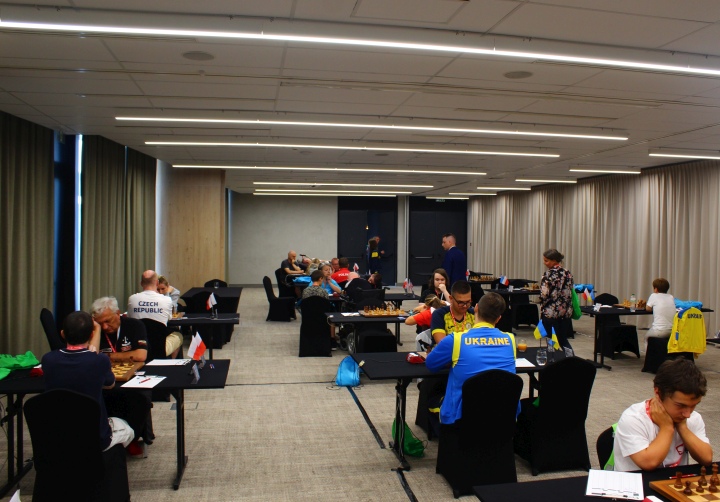
The 2023 FIDE World Championship for People with Disabilities, organized by the Polish Chess Federation, got underway in Lublin on August 18. The ten-day competition brought together 46 players from various parts of the world. With 22 participants, Polish players are the largest group in the championship, followed by the delegation of Ukraine, consisting of 12 participants. Other participants represent the Czech Republic, Italy, Spain, Israel, Kazakhstan, the United States and Angola. Polish GM Marcin Tazbir (FIDE rating 2500; pictured above) tops the starting list, followed by International Master Daniel Pulvett Marin (2496) from Spain. The third seed is Polish IM Łukasz Nowak (2408). Among the Women, the highest-rated player is Polish WIM Liliana Leszner (1936; pictured below), followed by her fellow countrywoman, 17-year-old Emilia Egeman (1870) and Woman FIDE Master Aleksandra Aleksandrova (1772) of Israel. The youngest participant is 12-year-old Szymon Barszcz and the oldest is Sławomir Sobocinski (pictured below), aged 69. Notably, the entire Polish team that won gold medals at this year’s Chess Olympiad for People with Disabilities in Belgrade (Tazbir, Molenda, Dukaczewski, Piekielny, Stachańczyk) is taking part in the competition. The fifth edition of the championship, a nine-round Swiss tournament with classical time control, is open to all players with visual, hearing and physical disabilities. Rounds 1-8 start at 3:00 PM, and Round 9 begins at 10:00 AM. The playing venue is located in the Arche Hotel Lublin. The tournament director is Paweł Zaskalski, while the chief arbiter IA Sabrina de San Vicente officiates the competition. The championship is financially supported by the Ministry of Sports and Tourism of Poland.
FIDE World Cup Round 7 Day 1: Carlsen and Muzychuk start with wins
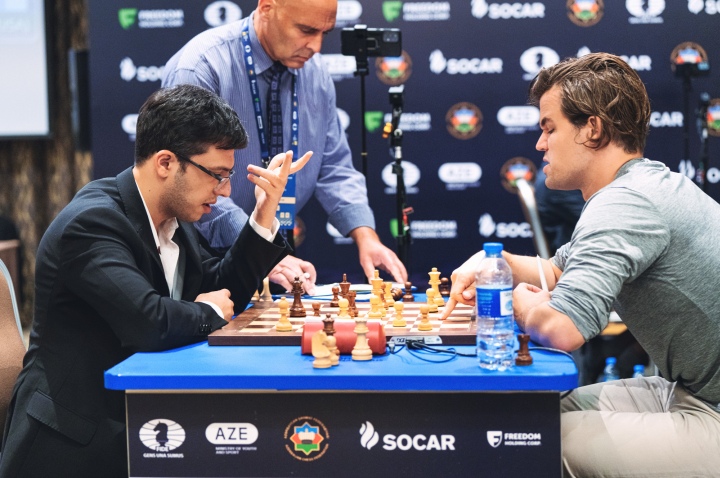
Magnus Carlsen is off to a good start in the semi-finals after defeating Azerbaijan’s Nijat Abasov in a very sharp game. Goryachkina and Salimova draw in the finals of the Women’s In the second semi-finals of the Open, Fabiano Caruana drew with white pieces against Praggnanandhaa in the longest game of the day. In the first duel of the Women’s finals, GM Aleksandra Goryachkina drew as White with 150 points lower rated Nurgyul Salimova in what was largely a calm game. Anna Muzychuk defeated former World Champion Tan Zhongyi in the first game of the match for third place. The Open Tournament Highlights Magnus Carlsen defeated the Azeri surprise Nijat Abasov in their first semi-final game. Playing as White, Carlsen went for the Rossolimo attack against the Sicilian. In a very sharp game requiring both sides to play extremely precisely, Carlsen grabbed the initiative. However, at one point he dropped his advantage and could have ended up in trouble had Black played the right move. Abasov did not find this continuation and misplayed. Carlsen then went for a dangerous plan after which Black could have equalised. But Abasov missed that chance as well and, instead, landed his king in a mating net. A huge success by Carlsen, making his first step towards reaching the finals of the World Cup – something he has never done before in his career. In the second game of the semi-finals, Fabiano Caruana and R Praggnanandhaa played until the bare kings were left on the board. In the main line of the Giuoco Piano, Caruana (White) got some initiative and pushed on the queenside. The two transitioned into a rook endgame in which Pragg smartly traded his two queenside pawns for White’s a-pawn, to reach a drawish position. The two played until move 78 when just the two kings were left standing. The Women’s Tournament Highlights The first game of the Women’s World Cup finals, played between Aleksandra Goryachkina as White and Nurgyul Salimova (who secured her GM norm!) as Black, ended in a draw. In the Queen’s Gambit Declined, Black (Salimova) gave up one pawn and then offered another, without visible compensation. Goryachkina accepted the frist gift but declined the second. She instead opted to exchange the queens and the two entered into a position where White had a weaker pawn structure on the queenside but could hold. In a knight vs bishop endgame, the two agreed to split a point on move 33. In the duel for third place, Anna Muzychuk was better with white pieces against former World Champion Tan Zhongyi, outplaying her in the finish of the game. In the English Opening, Muzychuk gained the initiative early on and was better on at least two occasions. In the endgame, where the position was even, Tan misplayed and allowed White to advance her king and b-pawn, before ending up without a bishop, in the end. The games continue on Sunday, 20th of August. A closer look at the games from today’s round will be published on the following link shortly: worldcup2023.fide.com/en/news Here follows a closer look at some of the top games from the semi-finals of the Open and the finals in the Women’s World Cup: Magnus Carlsen’s game against Nijat Abasov saw a lot of sharp twists and turns, requiring both sides to calculate various combinations and branches very precisely before deciding which path to follow. Carlsen went for the Rossolimo attack and suggested that his opponent was “clearly caught out” in the opening. White had an throughout the game then let it slip away and then made a serious mistake that could have cost him dearly. The best choice for White was to put his king to c3, securing his position a bit further. Instead, Carlsen went for 34.Qh2??. The top seed and his opponent missed 34…Qf1! – Black penetrates White’s camp and has a chance to soon bring his rook down and make serious threats against White. Abasov, however, missed this and soon blundered ending up weaker after both traded inaccuracies in subsequented play 34…Rg6? 35.Bf4 Rf6 36.Be3 Bf5? 37.Bc5 Qg6? 38.Kc3 Re6? 39.Rh4 Bg4 White is clearly better again, but now Carlsen made a mistake with 40.Bxa7? Qg3 or Qf4 were preferable options. 40…Qg7+ followed by Qg5, threatening to get to c1 offered Black equality. Instead, under time pressure, Abasov played 40…Qf6+? It turned out that there was a huge difference between the checks from g7 and f6 as on g7 the queen covers the c7-square. 41.Kb4! And now the white king escapes, wheras with the queen on g7 Black could have captured 41…Kxa7 41…Re6 42.d4 Qe7+ 43.c5 And Black will either have to give up a rook or face checkmate. 1-0 Caruana was pressuring Praggnanandhaa from the opening and trancisioned into a favourable rook ending. 40.Rc6? with this control move Fabiano missed a chance to pose some serious problems for Black. After 40.Ke3! Rc7 41. Kd2 Pragg would have had to demonstrate accuracy. As played, the young Indian quickly liquidated into 4:3 drawish rook endgame – 40…Rd7! 41.Rxa6 c3 42. Rc6 Ra7 43.a6 c2 44. Rxc2 Rxa6 – and reached a draw on move 78. The first game of the day to finish was between GM Aleksandra Goryachkina and the surprise of the 2023 Women’s World Cup, IM Nurgyul Salimova. The game did not bring about much excitement save for one point where White, according to the engine, had a chance to secure a sizable advantage: White is a pawn up. In the only previous game this position emerged (Malek – Bartel, 2023) Black opted for 12…Nc6 and got some compensation. Instead, Salimova sacrificed another pawn with 12…c5. The engines can’t not see any clear compensation for Black for the two pawns after simple 13.Qxc5. When asked about this after the game, Salimova said that she did not see anything wrong with the move and did not expect Goryachkina to take on c5, adding “there’s no way a human can play like this”, adding that White was significantly behind in development. Still, after thinking for 10 minutes, Goryackina decided not to
China Wins FIDE World Youth U16 Olympiad in Eindhoven, Netherlands

China emerged victorious in the FIDE World Youth U16 Olympiad held in Eindhoven, the Netherlands. The team dominated the competition, securing an impressive 17 out of 18 match points. Turkey, the last year’s champions, finished second, while Greece claimed the bronze medal. A record-breaking total of 252 players from 63 teams representing 47 countries participated in the Youth Olympiad, organized to commemorate the 150th anniversary of the Royal Dutch Chess Federation. The Chinese team ruled supreme in Eindhoven. Only Armenia managed to tie the match against the Chinese squad. Out of the 36 games played, China scored a total of 31 board points. Miaoyi Lu became the top scorer of the Chinese team, winning all her games on the fourth board. She also impressed chess fans and experts with her aggressive playing style. Tong(Qd) Xiao (board 2) and Xiangrui Kong (3rd board) both netted 7.5 out of 9, while Haowen Xue, on the top board, scored 7 points. FIDE President Arkady Dvorkovich visited the Youth Olympiad during the 6th and 7th rounds of the tournament. He extended his congratulations to the Royal Dutch Chess Federation on its 150th anniversary, commending it as a strong part of the chess community. The tournament was hosted by Eindhoven’s High Tech Campus. According to Dvorkovich, it is important to bring chess to the University campus and tech business. FIDE President expressed his hope that the participants made lasting friendships during the Youth Olympiad. Bianca de Jong-Muhren, President of the Royal Dutch Chess Federation, expressed her happiness at the successful conclusion of the tournament. “As part of the 150th anniversary of the Dutch Chess Federation KNSB, our aim was to host a prominent international youth event in the Netherlands. We are delighted with our accomplishment and the hosting of the Youth Olympiad in our country. It is also important that every team comprises both male and female players, aligning with our commitment to promote youth chess for all.” Final standings (top 10): 1 China 17 2 Turkey 15 3 Greece 13 4 Kazakhstan 1 13 5 Georgia 12 6 Kazakhstan 2 12 7 Armenia 12 8 Israel 12 9 Romania 12 10 Canada 1 12 Complete standings Board Prizes:Board 1: Read Samadov (Azerbaijan)Board 2: Tong(Qd) Xiao (China)Board 3: Xiangrui Kong (China)Board 4: Miaoyi Lu (China) Photos: Lennart Ootes and Frans Peeters Official website: youtholympiad2023.fide.com/
FIDE World Youth Olympiad 2023: Day 5 Recap
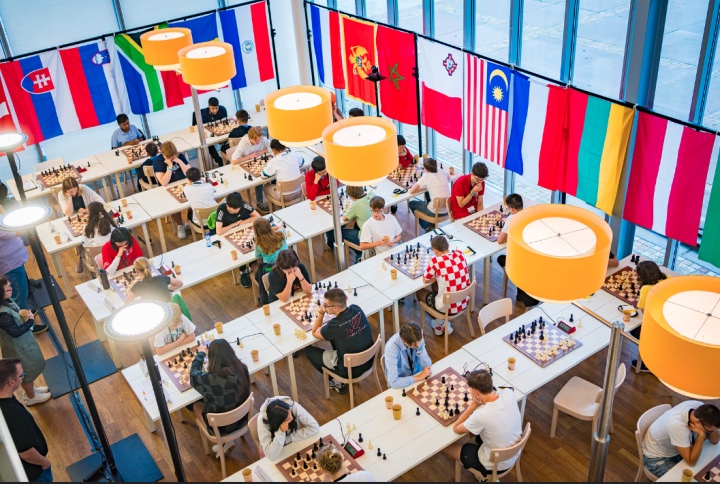
Two more rounds were played at the FIDE World Youth Olympiad 2023. That means a lot of hard work, both for the participants and for the reporters. But hard work is not the same as tedious work. On the contrary: as spectators, we’re getting a lot of value for our money. Round 7 All eyes were on the leader, China facing Armenia and especially on their star player Miaoyi Lu, who still had a perfect 100% score going into Round 7. Miaoyi Lu – Nvard Hayrapetyan 1. e4 c5 2. Nf3 e6 3. g3 Nc6 4. Bg2 d5 5. exd5 exd5 6. d4 Bg4 7. O-O Nxd4 8. Qe1+ Ne6?! The knight is awkwardly placed here. 8…Be7 would have been better, allowing Black to achieve a normal development after moves like 9. Nxd4 cxd4 10. Qe5 Nf6. 9. Ne5 Bf5 10. c4! White seizes the opportunity and forcefully opens the center. 10… Nf6 11. cxd5 Nxd5 12. g4 Bxb1 This seems to win a tempo since White has to capture back. After 13. Rxb1 Be7 It seems like Black can finally castle. However, she doesn’t get the chance: 14. Qe4 Ndc7 After 14…Nec7, 15. Rd1 follows, winning material. 15. Qa4+ b5 16. Bc6+ Kf8 17. Qe4 Black’s castling is prevented, and the rook on a8 becomes trapped. 17…Rc8 18. Bb7 Bd6 19. Bxc8 Qxc8 20. Le3 f6 21. f4! Nd8 After 21…fxe5 22. fxe5+ Black is in check. White regains the piece with interest and also obtains a dangerously advanced passed pawn. 22. Rbd1 Ne8 23. Kh1 Qe6 24. Bxc5 fxe5 25. fxe5+ Kg8 26. Bxd6 Nf7 27. Qd5 Qg6 28. Rf4 h5 29. Rdf1 Nf6 30. exf6 1-0 A textbook example of punishing opening mistakes. With two draws on the top boards, China seemed to be heading for victory. Xiangrui Kong appeared to be holding well against Benik Agasarov, until it all went terribly wrong towards the end: Black played the unfortunate 85…Qe4?? (Black could have held with something like 85…f4 ) and then after 86.Nf4+ Kg4 87.Qg6+ White delivered checkmate. 1-0 China suffered their first defeat in a game and conceded their first match point in the tournament after tying the match with Armenia. China is now at 13 match points after seven rounds; Armenia follows with 11 points. They are joined in the battle for second place by Kazakhstan 1, who won 2½-1½ against Uzbekistan, and Turkey, who defeated Ukraine 3-1. Uzbek player Afruza Khamdamova, along with Miaoyi Lu, was the only player with a 100% score before this round, but she had to settle for a draw after 119 moves against Alua Nurmanova. The game between Asronjon Omonov and Edgar Mamedov ended in a disaster for the white player. It might seem like there’s not much going on, but three moves later, it was all over for White: 56.h5?? Rcd8 57.Rf1?? Nf4 Suddenly, it’s Black who delivers checkmate! After 58.Bxf4 Rd1 Asronjon stopped the clock. 0-1 Eray Kilic took advantage of opponent Vladyslav Fishchuk’s overconfidence in the middle game, where Fishchuk moved his central pawns enthusiastically, leaving a few pieces hanging. Eray’s teammate Elifnaz Akat initially had less space after the opening and stood worse, until her opponent Roman Kovalskyi blundered in the following position: 24.Nb6?? The wrong piece. After 24.Bb6 Qd7 25.Rbd1, White stands much better. 24…dxe5! Suddenly, Black takes control. 25.Nxc8 exd4 26.Bxb7 Bxc8 27.Qd5 Black is winning, and on move 53, she delivered checkmate. 0-1 The first Dutch team secured a 2½-1½ victory against the well-performing Bangladesh. Yichen Han sacrificed a piece for two pawns but didn’t get the type of play he was looking for and eventually had to capitulate after defending for a long time. Arthur de Winter won a crucial pawn in the opening and gradually expanded his advantage into a win. In Prajit Sai Kumar’s game, the advantage swung back and forth, but in the end, White’s attack proved stronger than Black’s. Dana Verheij found herself in a difficult position in a queenless middlegame but managed to secure a crucial half-point for her team. Round 8 China secured victory in the Olympiad with one round to go. They defeated Hungary 4-0, a team that, on paper, wasn’t expected to lag behind China (with only a 49-point difference in average rating). This means that Miaoyi Lu still maintains a perfect score. Congratulations to the Chinese team, who, with 15 match points and 27½ board points, have an insurmountable lead: second-placed Turkey, after a 3½-½ victory against Kazakhstan, is 2 match points and 5 board points behind. Yagiz Kaan Erdogmus achieved a swift win after his opponent Daniyal Sapenov greedily grabbed a central pawn on move 19: The game continued with the daring 19…Nxe4?! 20.Ba7 Rxf4 21.Rd4, and here Black made a serious mistake with 21…Nxc3?. White’s advantage grew considerably after 22.Qxe6+ Rf7 23.Bxb8 d5 24.Re1, and a few moves later, Black resigned. 1-0 Armenia and Azerbaijan drew 2-2. The game between Khagan Ahmad and Erik R. Gasparyan exemplifies what can go wrong for White in the Novosibirsk Variation of the Sveshnikov Sicilian: If White now calmly continues with 14.0-0, there would be no issues. However, he made an instructive mistake 14.cxb5? Black responded to this flank action with the classic Sicilian counteraction in the center: 14…d5!. It is a key move in virtually every Sicilian, and this situation is no exception. After 15.bxa6 0-0 16.0-0 fxe4 17.Bb5 Rd8, Black gained a powerful block of central pawns. Black’s advantage remained unchallenged, and it was a matter of time when the Tetris block started moving. Once that happened, White had no chance. 0-1 Netherlands 1 lost 2½-1½ against Austria. Yichen Han played a draw in a game that hasn’t strayed far from equality. In the endgame, Prajit Sai Kumar failed to neutralize Black’s passed pawn while trying to protect his own kingside pawns, leading to the pawn becoming an increasingly troublesome presence on the board. Dana Verheij didn’t find the strongest defence and succumbed to weaknesses around her king. Arthur de Winter won, although it required a fair share of luck: The position here is evaluated as 0.0 according to the engines. However, in the next five moves, the Lichess engine gives

